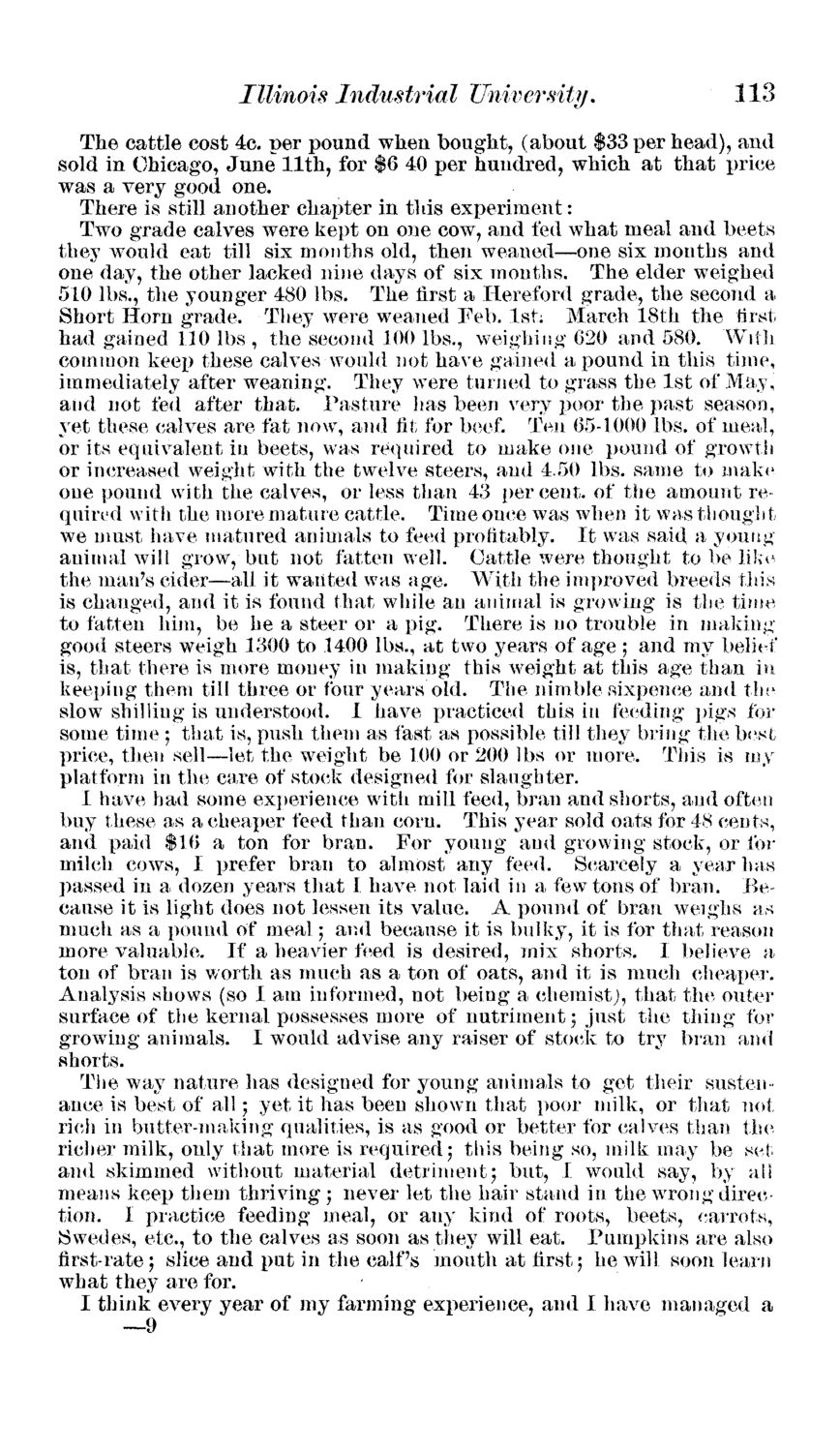| |
| |
Caption: Board of Trustees Minutes - 1874
This is a reduced-resolution page image for fast online browsing.

EXTRACTED TEXT FROM PAGE:
Illinois Industrial University. 113 The cattle cost 4c. per pound when bought, (about $33 per head), and sold in Chicago, June 11th, for $6 40 per hundred, which at that price was a very good one. There is still another chapter in this experiment: Two grade calves were kept on one cow, and fed what meal and beets they would eat till six months old, then weaned—one six months and one day, the other lacked nine days of six months. The elder weighed 510 lbs., the younger 480 lbs. The first a Hereford grade, the second a Short Horn grade. They were weaned Feb. 1st; March 18th the first had gained 110 lbs , the'second 100 lbs., weighing 620 and 580. With common keep these calves would not have gained a pound in this time, immediately after weaning. They were turned to grass the 1st of May, and not fed after that. Pasture lias been very poor the past season, yet these calves are fat now, and fit for beef. Ten 65-1000 lbs. of meal, or its equivalent in beets, was required to make one pound of growth or increased weight with the twelve steers, and 4.50 lbs. same to make one pound with the calves, or less than 43 per cent, of the amount required with the more mature cattle. Time once was when it was thought we must have matured animals to feed profitably. It was said a young animal will grow, but not fatten well. Cattle were thought to be like the man's cider—all it wanted was age. With the improved breeds this is changed, and it is found that while an animal is growing is the timeto fatten him, be he a steer or a pig. There is no trouble in making good steers weigh 1300 to 1400 lbs., at two years of age ; and my belief is, that there is more money in making this weight at this age than in keeping them till three or four years old. The nimble sixpence and the slow shilling is understood. I have practiced this in feeding pigs for some time; that is, push them as fast as possible till they bring the best price, then sell—let the weight be 100 or 200 lbs or more. This is my platform in the care of stock designed for slaughter. I have had some experience with mill feed, bran and shorts, and often buy these as a cheaper feed than corn. This year sold oats for 48 cents, and paid $16 a ton for bran. For young and growing stock, or for milch cows, I prefer bran to almost any feed. Scarcely a year has passed in a dozen years that I have not laid in a few tons of bran. Because it is light does not lessen its value. A pound of bran weighs as much as a pound of meal; and because it is bulky, it is for that reason more valuable. If a heavier feed is desired, mix shorts. I believe a ton of bran is worth as much as a ton of oats, and it is much cheaper. Analysis shows (so I am informed, not being a chemist;, that the outer surface of the kernal possesses more of nutriment; just the thing for growing animals. I would advise any raiser of stock to try bran and shorts. The way nature has designed for young animals to get their sustenance is best of all; yet it has been shown that poor milk, or that not rich in butter-making qualities, is as good or better for calves than the richer milk, only that more is required; this being so, milk may be set ami skimmed without material detriment; but, I would say, by all means keep them thriving; never let the hair stand in the wrong direction. I practice feeding meal, or any kind of roots, beets, carrots, •Swedes, etc., to the calves as soon as they will eat. Pumpkins are also first-rate; slice and put in the calf's mouth at first; he will soon learn what they are for. I think every year of my farming experience, and I have managed a —9
| |